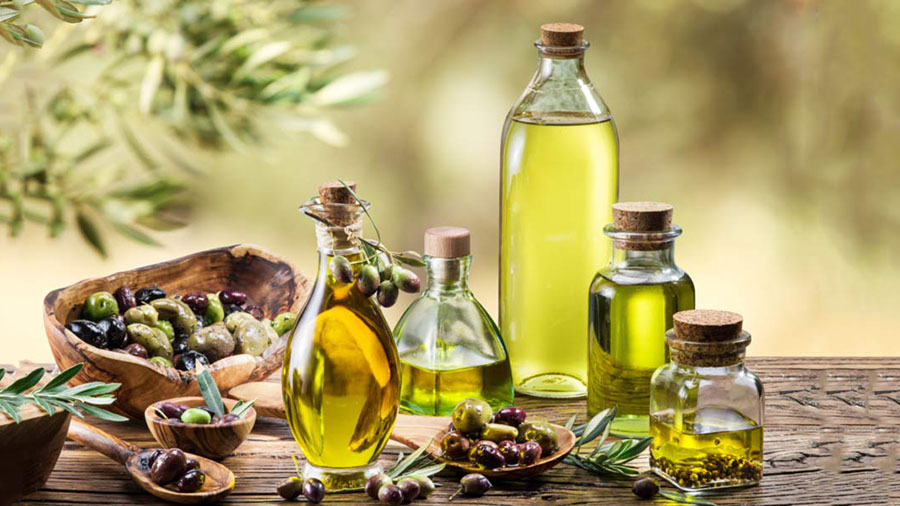Olive Oil - Liquid Gold
Athena the Goddess of Wisdom according to Greek Mythology planted the very first olive tree on the sacred rock of the Acropolis. The state and city of Athens got its name from this Ancient Greek Goddess. Athens as a city also enjoyed the benefits concerning the social and economical aspect of the cultivation of the olive tree. The olive tree since then has symbolized peace, light, Victory crowning athletes during the Olympic games and finally a symbol of wisdom.
The truth of the matter is though that the first olive trees ever cultivated in European soil are the ones of Crete, during the Neolithic and Bronze age era.
The liquid gold as its often referred to in Crete was cultivated first round 3500.B.C.
The cultivation of the olive tree not only was part of the every day Minoan diet, base of perfume, oil lamps, preserving food, medicine, body rub, witchcraft, soap, religious ceremonies, care of the dead and finally generated trading with the Levant and Middle East.
Today olive oil still plays a key role in Orthodox Greek Christian religion, as it is used in the baptismal font,the baptized child and in the oil lamps of our churches.
The oldest largest olive field of the Eastern Mediterranean is found here in Crete, Crete has more olive trees that the population of Greece.
Some of the oldest olive trees in the world are found in Crete.
In 2004 during the Olympic games held in Athens an olive branch from the oldest olive tree(4000 year old tree)of Crete was sent initiating the beginning of the Olympic games!
This shallow rooted tree with its gnarled tree trunk has stood side by side with the earthbound people of this island through all out their history, their hardships, their victories, their grief their hopes like a silent witness.
The Cretan diet famous for its attributes is based on olive oil, in fact the Mediterranean diet is the Cretan diet!
The liquid gold that brings together whole families and villages during autumn and winter harvest has many varieties depending on the type of tree, time of harvest, type of pressing.
Like wine olive oil varies and dresses our food accordingly.
You can experience the variety, flavors, types of olive oil and olives of Crete all you have to do is join WeGuide and the history of this fruit and its characteristics shall be enjoyed, did you know that you can find in Crete olive oil mixed with spices?
Olive oil mixed with herbs?
Olive oil mixed with citrus blossoms?
Did you know that different dishes, salads styles of cooking involve types of olive oil?
The people of Crete have been cultivating, cooking and enjoying olive oil for more than 5000 years!
Weguide, enlightens you through our designed tours to get to know and fully appreciate the liquid gold of Crete.
Health Benefits Of Olive Oil
The health benefits of olive oil include treatment for colon, breast cancer, diabetes, heart problems, arthritis, high cholesterol, weight loss, metabolism, digestion, aging and cancer. It has been used by mankind for many centuries. It is a staple ingredient for many culinary preparations and also serves a variety of medicinal purposes. Medical studies suggest that it is loaded with health benefits.
It helps in lowering of the bad cholesterol level in our blood, as it is rich in monounsaturated fats. The extra virgin olive oil variety contains the highest level of antioxidant polyphenols and oleic acid. It is thus a healthy option compared to other vegetable oils.
But, it also has lots of calories, so it should be used in moderate amounts for the best health results. The Food and Drug Administration recommends 2 tablespoons every day to reduce the risk of heart disease.
Important Sources: Olive oil, as we all know, is an essential fruit oil, which we get from the olive tree crop found mainly in the Mediterranean regions. It is utilized for cooking purposes, developing cosmetic products and soaps, for medicinal purposes, and as pharmaceutical supplements. It can also be used as fuel and for lighting lamps.
Various types include the following:
Virgin Olive Oil: This variety is used for cooking with a lower acid content.
Extra Virgin Olive Oil: This is a much better variety and is made by cold pressing the olive fruit.
Pure Olive Oil: This type is a combination of refined and virgin oils. It contains a highly acidic content.
Lampante Oil: It is used as a fuel and is not recommended for cooking purposes.
Health Benefits Of Olive Oil
It has numerous beneficial qualities. Apart from being a good cooking aid, it is also known to have unique medicinal qualities. Some of them are as follows:
Reduce Heart Problems: Natural olive oil contains 70% monounsaturated fatty acid. As a result, it lowers cholesterol accumulation in the blood and reduces heart problems. It reduces the LDL, while at the same time increasing the HDL levels. The website of Montelcastelli Solutions Ltd. provides a table comparing the fatty acid composition of different types of oils.
Blood Cholesterol: LDL cholesterol is the bad type of cholesterol, which increases the risk of heart attacks and pulmonary heart disease. Extra virgin olive oil, which is rich in almost 40 antioxidant chemicals, helps reduce the oxidation effects of LDL cholesterol.
Weight Loss: Medical experts suggest that it is very difficult to gain weight from the mono-unsaturated fats present in olive oil. Experiments involving Mediterranean olive oil have shown positive results in regards to a reduction in human body weight.
Metabolism: Olive oil boosts the metabolism, the growth of good bone structure, and brain development in children. It is an excellent source of vitamin E, which is very beneficial for older people.
Anti-inflammatory and Antimicrobial Properties: The phenols present in olive oil have anti-inflammatory properties. The antimicrobial characteristics of the oil are a result of its strong aroma.
Digestion: Olive oil is known to aid in the digestive process. It is used as a medicinal oil to clean the digestive tract and to improve bowel movements.
Aging Process: Rich in antioxidants, olive oil slows the natural aging process of the human body. Used in cosmetic products and natural herbal therapy, it does wonders for the skin, which gets a natural shine and glow from the enriching oil.
Prevention of Gall Stones: This oil is also effective in preventing gall stones.
Healthy Cell Walls: Olive oil contains polyphenol which helps in stronger cell walls. It also increases the elasticity of arterial walls, protecting against various heart conditions.
Cancer: Olive oil is said to protect the human body against cancerous growth, especially bowel cancer. Medical research done at the prestigious Oxford University has shown positive signs that the acidic content of this oil can prevent the commencement of rectum and bowel cancer. In the UK, bowel cancer is one of the most prevalent forms of cancer, and kills almost twenty thousand citizens every year.
Breast cancer: Recent research study suggests that hydroxytyrosol, a major component of olive oil may help prevent breast cancer in postmenopausal women.
Hypertension: Recent research study suggests that Mediterranean diet comprising of food rich in unsaturated fats (found in olive oil and nuts) and nitrite and nitrate (found in leafy green vegetables) may help protect you from hypertension.
There are several grades of olive oil, according to the flavor, aroma, acidic value and color. Readers are advised to buy authentic oil with proper evaluation for cooking or medicinal purposes.
Grades Of Olive Oil
When you go in the market, you find different types of olive oils. What does extra virgin olive oil mean? What does US Fancy olive oil mean? There are two main types of gradations that you will find, IOOC standards and US standards.
IOOC Standards
The International Olive Oil Council ( IOOC) has released the Trade Standard Applying to Olive Oils and Olive-Pomace Oils. The council has provided descriptions for different types of oils; some of these descriptions are given below:
Virgin Olive Oil: It is the oil that is prepared from purely mechanical and physical means. There is no alteration to the oil after processing. Edible virgin oil has a free acidity of not more than 2 grams per 100 grams. No food additives are permitted in this oil.
Extra Virgin Olive Oil: This is a type of edible oil, which has a free acidity content of no more than 0.8 grams per 100 grams. No additives are permitted in this oil.
Ordinary Virgin Olive Oil: This has a free acidity content of no more than 3.3 grams per 100 grams. This oil does not contain any additives.
Lampnate Virgin Olive Oil: This oil is not fit for human consumption. It has a free acidity content of more than 3.3 grams per 100 grams. It is used for refining and technical purposes.
Refined Olive Oil: It is the refined form of virgin olive oil. It has a free acidity content of not more than 0.3 grams per 100 grams.
Olive Oil: This is a blend of refined and edible virgin olive oil. It has a fatty acid content of not more than 1 gram per 100 grams.
US Standards
The United States Department of Agriculture (USDA) released the United States Standards for Grades of Olive Oil in 1948. These standards are still followed in the US and this has, to some extent, caused problems for consumers in purchasing the right kind of olive oil.
The USDA grades olive oil in the following four categories:
- US Grade A or US Fancy
- US Grade B or US Choice
- US Grade C or US Standard
- US Grade D or Substandard
The grading is done based on free fatty acid content (calculated as oleic acid according to the Official and Tentative Methods of Analysis of the Association of Official Agricultural Chemists), absence of defects, (degree of freedom from cloudiness at 60 degrees F), odor (typical olive oil odor and its variation to off-odors) and flavor (typical olive oil flavor and its variation to off-flavors). It has given a 100 point score sheet for olive oil in which free fatty acid content, absence of defects, odor, and flavor have weights of 30, 30, 20 and 20 respectively.
Fancy: US Fancy refers to olive oil that has a fatty acid content of no more than 1.4 percent (27-30 points). It should be entirely free from any defects (27-30 points). It should have good typical olive oil odor (18-20 points). It should have good typical olive oil flavor (18-20 points). Finally, it should have a total score of no less than 90 points.
Choice: US Choice refers to olive oil that has a fatty acid content of more than 1.4 percent but not more than 2.5 percent (24-26 points). It should be reasonably free from any defect (24-26 points). It should have a reasonably typical olive oil odor (16-17 points). It should also have a reasonably good olive oil flavor (16-17 points). It should have a score of no less than 80 points.
Standard: US Standard refers to olive oil that has a fatty acid content of more than 2.5 percent but less than 3.0 percent (21-23 points). It should be fairly free from any defect (21-23 points). It should have fairly good typical olive oil odor (14-15 points). It should have fairly good typical olive oil flavor (14-15 points). It should have a score of no less than 70 points.
Substandard: Substandard refers to olive oil that has free fatty acid content of more than 3.0 percent (0-20 points). It has more defects than what is present in the US Standard type of oil (0-20 points). It fails to have even a fairly good typical olive oil odor (0-13 points). It fails to have a fairly good typical olive oil flavor (0-13 points). It has less than 70 total points.
References: Oxford University and Food and Drug Administration






